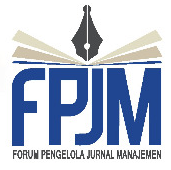Segmentasi Layanan Internet Banking
Abstract
The purpose of this study is to analyze internet banking’s users based on their experiences. It can be used to set marketing program of internet banking that appropriate with customers needs, in order to anticipate tight competition. This research methods starts with focus group discussion and clustering analysis to classify 312 respondents of internet banking users based on demographic, benefit and behavioral segmentation. The sampling method uses purposive sampling and snowball sampling. K-Means Clustering method’s produces four optimal clusters. The benefit orientation of the first cluster in on time saving. Second cluster, concern on the ease of getting and operating internet banking so this cluster does not need auxiliary features such as video guide to use internet banking. The third cluster’s orientation is on the modern lifestyle and the ease of getting and operating internet banking service with detailed daily mutation transaction The fourth cluster, concerns on the detailed daily mutation transaction but they are not sure with the security of personal data via internet banking.
https://doi.org/10.26905/jmdk.v4i2.644
Keywords
Full Text:
pdfReferences
Akinci, S., Safak, Aksoy., dan Eda, Antilgan. (2004). Adoption of Internet Banking Among Sophisticated Consumer Segments in An Advanced Developing Country, International Journal of Bank Marketing, Vol 22, No 3, pp 212-232.s
Alfansi, Lizar, dan Adrian Sargeant. (2000). Market Segmentation in the Indonesian Banking Sector: The relationship between demographics and desired customer benefits, International Journal of Bank Marketing, Vol 18, No 2, pp 64-74.
Asosiasi Penyelenggara Jasa Internet Indonesia. (2015). Profile Pengguna Internet Indonesia 2014, diunduh tanggal 11 Januari 2016, dari https://www.sendspace.com/file/mke4ig
Bank Indonesia. (2012). Mengenal Electronic Banking, diunduh tanggal 12 Januari 2016, dari http://www.bi.go.id/NR/rdonlyres/24CDE8AA-F4F1-4523-9FCE-7F92A5A96DC6/1490/MengenalElectronicBanking.pdf.
Chih-Chin, Liang., Chung-Wen Yang., Pei-Ching Wu., Chu-Fen Li. (2012). Market Segmentation to Mobile Banking Service, Advances in Information Science and Service Sciences, Vol 4, No 19, pp 197-204.
Ghozali, Imam. (2011), Aplikasi Analisis Multivariate dengan Program IBM SPSS 19, Edisi 5, Semarang: Badan Penerbit Universitas Diponegoro.
Hair, Joseph F., William C. Black., Barry J.Babin., Rolph E.Anderson., Ronald L. Tatham. (2010). Multivariate Data Analysis, 7th ed, Upper Saddle River: Pearson Prentice Hall, Inc.
Haley, Russell I. (1968). Benefit Segmentation: Decision-oriented Research Tool, Journal of Marketing, Vol 32, pp 30-35.
Kotler, Philip dan Gary Armstrong. (2016). Principles of Marketing Global, Global Edition, 16th ed, Upper Saddle River: Pearson Education Limited.
Kotler, Philip dan Kevin Lane Keller. (2016). Marketing Management, 14th ed, Upper Saddle River: Pearson Education Limited.
Maenpaa, Katariina. (2006). Clustering The Consumers on the Basis of Their Perceptions of the Internet Banking Services. Internet Research, Vol 16, pp 304-332.
McDonald, Malcom dan Ian Dunbar. (2004). Market Segmentation, London: Licensing Agency Ltd.
Minhas, Raj Singh dan Everett M. Jacob. (1996). “Benefit Segmentation by Factor Analysis: an improved method of targeting consumers for financial services. International Journal of Bank Marketing, Vol 14, No 3, pp 3-14.
Mullins, John W., Orville C, Walker., Harper, W Boyd. (2008). Marketing Management, A Strategic Decision-Making Approach, 6th ed, New York: McGraw-Hill Irwin.
Plummer, Joseph T. (1974). The Concept and Application of Life Style Segmentation, Journal of Marketing, Vol 38, pp 33-37.
Price Waterhouse Coopers. (2015). Indonesian Banking Survey 2015, diunduh tanggal 12 Januari 2016, dari https://www.pwc.com/id/en/publications/assets/banking-survey-2015.pdf.
Sharingvision.com. (2015) Pertumbuhan Internet Banking di Indonesia, diakses tanggal 11 Januari 2015, dari http://sharingvision.com/2015/05/pertumbuhan-internet-banking-di-indonesia/
Snellman, Kaisa. (2000). From One Segment to A Segment of One – The Evolution of Market Segmentation Theory (Working Papers, Swedish School of Economics and Business Administration, 2000). Working Papers, 16. Diunduh tanggal 30 Mei 2013 dari https://helda.helsinki.fi/bitstream/handle/10227/128/416-951-555-629-5.pdf?sequence=2.
We are social.com. (2016). Digital in 2016, diunduh tanggal 17 Pebruari 2016 dari http://www.slideshare.net/wearesocialsg/digital-in-2016
Wells, William D., Douglas J, Tigert. (1971). Activities, Interests and Opinions, Journal of Advertising Research, Vol 11, No 4, pp 27-35.
Yankelovich, Daniel. (1963). New Criteria for Market Segmentation, Harvard Business Review, Vol 42, pp. 83-95.
Yankelovich, Daniel dan David Meer. (2006). Rediscovering Market Segmentation, Harvard Business Review, Vol 84, pp. 122-131.
Yunianto, Ahmad dan Catur Sugiyanto. (2003). Benefit Segmentation Case of a National Bank’s Customers in Indonesia, Gadjah Mada International Journal of Business, Vol 5, No 3, pp. 301-319,
DOI: https://doi.org/10.26905/jmdk.v4i2.644
Refbacks
- There are currently no refbacks.
Indexing by:
| | |
Index Copernicus International (ICI)
Tools:
In Collaboration with:
 |
Jurnal Manajemen dan Kewirausahaan Management Department Faculty of Economics University of Merdeka Malang MAILING ADDRESS
|





